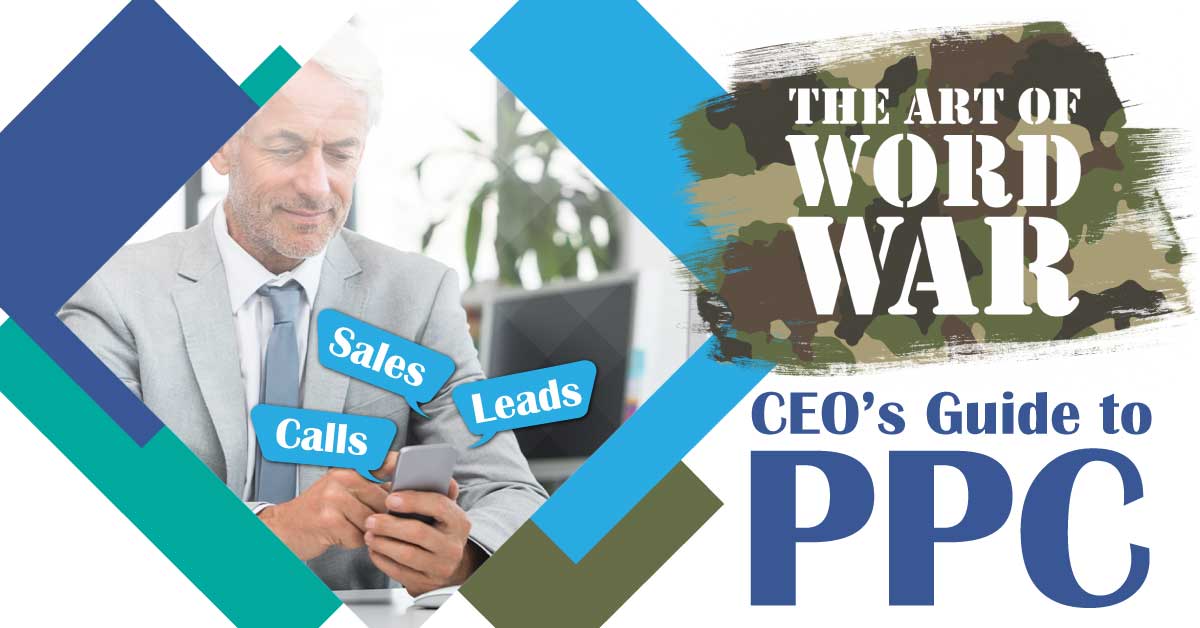PPC is normally the first thing implemented in a Digital Marketing Plan because it’s fast, measurable, and provides crucial data. The downside of PPC is the cost, and as CEO, you have to implement cost controls to make sure it’s a good investment. CEOs drive the vision and strategy and never have enough time. The CEO Guide series is not a detailed how-to guide. We avoid getting too deep into the weeds and stay with the task of managing the strategy, not executing the tactics.
Recommendation Summary
For those that want just the article highlights here they are:
- Never take your finger off the pulse:
- Set CPA (Cost Per Action)
- Set VOA (Volume Of Actions)
- Monitor Goals and Actuals Monthly
- Do NOT Set It and Forget It
- Smell the Exhaust
- Would you buy that search?
- Would your ideal customers search like this?
- Does the search include intent to engage your services or buy your products?
- Hire a PPC Coach for CEO & Account Manager
We will start today with a true story of a CEO losing control of PPC and follow that with specific recommendations on how to avoid writing a similar story in our business. All while staying at the 50,000-foot level.
Never Waste a Perfectly Good Disaster
We, unfortunately, have way too many stories where a CEO lost strategic control of PPC, creating an emergency situation. In this case, as it is with many, our phone rang late on a Friday afternoon. The CEO was in a panic because they were completely missing from the Google results, their phones had gone dark, and their website was offline. They had tried for two days to reach their PPC support person, but they had disappeared (presumably looking for Nessie). While we would not learn this for several days, this account had actually been degrading for some time and it was only when the website vanished that the CEO stepped in.
Emergency Declared
The website vanishing was due to the domain expiring which was easily fixed. They paid their bill and the site was back up and running but the account performance was far from being healthy. We dug into their Google Ads account (previously Google AdWords), and their quality score was in the toilet, with the highest Quality Score being a 3. We dug deeper and found keyword to content misalignment. They were paying big dollars for keywords that were not even in their content. As the quality score degraded, their PPC manager simply kept increasing the bids in an attempt to overpower the system. The net effect was the client’s credit card was set on fire. We paused the poorly supported keywords and rewrote ads to improve quality score relevance. By Monday, they were functional but a long way from fully recovered.
Moving from Triage to Preventive Health
Over the next several weeks, we worked with the client on their content putting in keyword support into their content and bringing them back online. We deleted keywords that were attracting traffic but lacked the intent to engage their services. We reorganized keywords into narrowly defined groups and tightened up the ad content. As the quality score improved, we reduced bids gradually to bring the CPA more in line with what the Client needed to make their business model work. We discovered more deferred maintenance including several website names that had been purchased as part of an SEO strategy. These site names had different registrars and hosts and this nightmare took a few days to get our hands around. The SEO manager had implemented several tricks that Google has long since figured out how to detect. We suspected that this was further impacting current organic traffic. A bad quality score is a good indicator of SEO score problems so we unraveled these tricks as well. Within 30 days, SEO traffic started to return and odds were good that Google was slowly but surely forgiving their past sins.
Moral of the Story
This story and a dozen more just like it have a common theme. The damage happened over a long time in silent killer mode. This probably would have continued except for the blessing in disguise of the domain expiring. If that had not happened, this walking dead website might still be causing damage and burning cash. Below are four simple steps CEOs can implement today that will stop you from owning your very own Google Ads Disaster story.
Recommendations
1. Never take your finger off the pulse of PPC
Sales is a game of numbers and in PPC, the big ones are CPA (Cost Per Action) and VOA (Volume of Actions). These are easy to watch and they should be on your monthly CEO Dashboard. Actions (i.e. Acquisitions, Conversions, Leads, Orders, Subscriptions, etc.) are simply actions you deem of value to the business. Do not let acronyms or industry jargon confuse you; they are all the same thing.
Running a Google Ads Account without a target CPA and VOA is a disaster looking for a place to happen. The common sense rule is “No Target CPA & VOA – No Money” but as we all know, common sense is not always that common. Check the actual goals each month and insist on a correction plan if they are headed in the wrong direction.

A low CPA risks loss of revenue while a high CPA causes declining profits or even bankruptcy. CPA falls into the Goldilocks principle – not too high, not too low, just right. There are many things that can move the CPA but that is getting too deep into the weeds for a CEO Guide Article. Make sure you have a target CPA and that your staff reports on that regularly. If it goes out of balance, insist on a correction plan to bring it back in balance. If you need help getting to your target CPA, give us a call. We would be glad to assist in this process.
VOA (Volume Of Actions) is closely related to the CPA. Every business plan has, at its core, a revenue target and for that, you need a certain amount of new business. Any CEO worthy of the title will know their target. Most initial actions are often one or more steps removed from direct revenue so the VOA often has to be calculated.
For example, if you need 4 new clients each month to meet your revenue targets and your Sales Department closes 50% of their leads. This means you need 8 new leads plus two times your monthly attrition rate. With your CPA and VOA in hand the budget is simple math:
CPA x VOA = Budget
 2. Do NOT set it and forget it
2. Do NOT set it and forget it
CEOs get lured into thinking that PPC is a project with a start and stop date that can be finished. This is a myth put forward by software developers who are not Google Ads Experts. These developers have never had to turn a profit in a PPC account and they think their software is way smarter than it really is. Artificial Intelligence, Machine Learning, and all their software cousins are a long way from understanding the nuances of language and human interaction with your business.
PPC is a never-ending and evolving process that is an integral part of the business ecosystem. PPC exists at the junction of people, language, and systems and it is complicated. If you set it and forget it, it will eventually lose its mind and drive full speed into the closest immovable object. Unfortunately, there are many people, including Google, that will attempt to convince CEOs that their software cures this – they are lying to you. Set it and forget it is a strategy that creates an accident looking for a place to happen.
PPC is more than just Google Ads but I will use that as the example network. Each year, Google announces hundreds of changes and nobody knows how many are unannounced but we know it’s a lot. Each change represents an opportunity or risk or both to your account performance. If Google does not change the rules, your competitors certainly will. If you have a strong profitable position, your competitor is not going to roll over and let you have it. They will fight and no account can just stand there and take blow after blow without experiencing pain.
PPC is complicated but as a CEO you just have to make sure you hire smart people and guide them on the vision and goals. People are people and you have to hold them to higher performance than they would hold themselves. This is why they gave you the title of CEO.
 3. Smell the Exhaust
3. Smell the Exhaust
Auto mechanics use an analyzer that sniffs the exhaust and provides engine performance insights. In Google Ads, we have “Search Terms”, which is our system exhaust which provides insights into performance. Require your PPC person to send a report of your top 100 search terms every month. This takes only seconds to create and export to a spreadsheet that they can email to you. Then spend five minutes looking at the searches and ask yourself:
- Would you buy that search?
- Would your ideal customers search like this?
- Does the search include intent to engage your services or buy your products?
Then ask your Account Manager about any that get a ‘no’ from the questions above. Do that every month and your account will become more tuned to your vision. You will quickly learn that you really only need to look at the Top 10 and ask questions to keep your PPC direction aligned with the business vision and goals. Many CEOs find that they can get this down to just a few minutes each month.
 4. Hire a PPC Coach
4. Hire a PPC Coach
The first question is “How Important is PPC?” If the answer is some form of high or very high then consider hiring a PPC Coach. How much you engage your coach depends on how far you want to go and how fast you want to get there. As CEO, you oversee the person that has day-to-day account management responsibilities, either internal or external. You do not need to be smarter than they are but you have to understand enough to appreciate the value they bring to the business. You also need to be up to date on the PPC opportunities and risks. Most CEOs can get this done with an hour a month but they often start with an hour a week. They run weekly until they are confident in their ability to oversee and direct strategy. Then back it down to once a month to stay up to date. Some companies keep the coach at once a week but they move 75% of those hours to the account manager, reserving one hour for an update briefing. This expands the resources of the employee managing the account and gives them a professional second opinion. This gives the business an outside PPC auditor and a backup/transition plan if the employee resigns or fails to meet their sales goals.
 Wrap it up and put a bow on it
Wrap it up and put a bow on it
CEOs direct and control the vision and strategy of PPC but they are rarely PPC experts. By monitoring a couple of key points and asking tough questions, you can control the strategy and delegate the tactics. You can execute items 1,2 & 3 in less than an hour a month.



 2. Do NOT set it and forget it
2. Do NOT set it and forget it 3. Smell the Exhaust
3. Smell the Exhaust  4. Hire a PPC Coach
4. Hire a PPC Coach  Wrap it up and put a bow on it
Wrap it up and put a bow on it